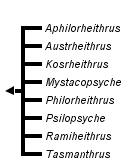Philorhethridae
Ralph W. Holzenthal, Roger J. Blahnik, Aysha Prather, and Karl Kjer


This tree diagram shows the relationships between several groups of organisms.
The root of the current tree connects the organisms featured in this tree to their containing group and the rest of the Tree of Life. The basal branching point in the tree represents the ancestor of the other groups in the tree. This ancestor diversified over time into several descendent subgroups, which are represented as internal nodes and terminal taxa to the right.

You can click on the root to travel down the Tree of Life all the way to the root of all Life, and you can click on the names of descendent subgroups to travel up the Tree of Life all the way to individual species.
For more information on ToL tree formatting, please see Interpreting the Tree or Classification. To learn more about phylogenetic trees, please visit our Phylogenetic Biology pages.
close boxIntroduction
Philorheithridae is another small family of about 25 species that shows a trans-Antarctic distribution, with genera endemic to Australia, Tasmania, New Zealand, or southern Chile and adjacent Argentina. There are 8 genera, with about 2-6 species each, distributed as follows: southern Chile, Argentina (Mystacopsyche Schmid, Psilopsyche Ulmer), southeast Australia, Tasmania (Austrheithrus Mosely, Aphilorheithrus Mosely, Kosrheithrus Mosely, Ramirheithrus Neboiss, Tasmanthrus Mosely), and New Zealand (Philorheithrus Hare). The 2 earliest named genera, Psilopsyche Ulmer and Philorheithrus Hare, were originally described in the Odontoceridae and Sericostomatidae, respectively. Mosely (1936) established the family, with Philorheithrus as its type genus. The semi-raptorial morphology of the fore- and midlegs of the larvae reveal their predatory behavior. Larvae construct stout, tubular cases of sand grains and live on or in sandy bottom sediments in small to medium-sized rivers. In the males of most species, there is a pair of “pilifers:” digitate, semimembranous structures, emerging dorsad of the maxillary palps and held in front of the face. Some males have pectinate antennae. In general, these are rather large caddisflies, with wing lengths of about 1-1.5 cm. (From Holzenthal et al., 2007)References
Holzenthal R.W., Blahnik, R.J., Prather, A.L., and Kjer K.M. 2007. Order Trichoptera Kirby 1813 (Insecta), Caddisflies. In: Zhang, Z.-Q., and Shear, W.A. (Eds). 2007 Linneaus Tercentenary: Progress in Invertebrate Taxonomy. Zootaxa. 1668:639–698.
Mosely, M.E. (1936) Tasmanian Trichoptera or caddis-flies. Proceedings of the Zoological Society of London, 1936, 395–424.
About This Page
Ralph W. Holzenthal

University of Minnesota, St. Paul, Minnesota, USA
Roger J. Blahnik

University of Minnesota, St. Paul, Minnesota, USA
Aysha Prather

Centre for Biodiversity and Conservation Biology, Royal Ontario Museum, Toronto, Ontario, Canada
Karl Kjer

Rutgers University, New Brunswick, New Jersey, USA
Correspondence regarding this page should be directed to Ralph W. Holzenthal at , Roger J. Blahnik at , Aysha Prather at , and Karl Kjer at
Page copyright © 2010 Ralph W. Holzenthal, Roger J. Blahnik, Aysha Prather, and Karl Kjer
 Page: Tree of Life
Philorhethridae.
Authored by
Ralph W. Holzenthal, Roger J. Blahnik, Aysha Prather, and Karl Kjer.
The TEXT of this page is licensed under the
Creative Commons Attribution-NonCommercial-ShareAlike License - Version 3.0. Note that images and other media
featured on this page are each governed by their own license, and they may or may not be available
for reuse. Click on an image or a media link to access the media data window, which provides the
relevant licensing information. For the general terms and conditions of ToL material reuse and
redistribution, please see the Tree of Life Copyright
Policies.
Page: Tree of Life
Philorhethridae.
Authored by
Ralph W. Holzenthal, Roger J. Blahnik, Aysha Prather, and Karl Kjer.
The TEXT of this page is licensed under the
Creative Commons Attribution-NonCommercial-ShareAlike License - Version 3.0. Note that images and other media
featured on this page are each governed by their own license, and they may or may not be available
for reuse. Click on an image or a media link to access the media data window, which provides the
relevant licensing information. For the general terms and conditions of ToL material reuse and
redistribution, please see the Tree of Life Copyright
Policies.
- First online 17 July 2010
- Content changed 20 July 2010
Citing this page:
Holzenthal, Ralph W., Roger J. Blahnik, Aysha Prather, and Karl Kjer. 2010. Philorhethridae. Version 20 July 2010 (under construction). http://tolweb.org/Philorhethridae/14592/2010.07.20 in The Tree of Life Web Project, http://tolweb.org/





 Go to quick links
Go to quick search
Go to navigation for this section of the ToL site
Go to detailed links for the ToL site
Go to quick links
Go to quick search
Go to navigation for this section of the ToL site
Go to detailed links for the ToL site